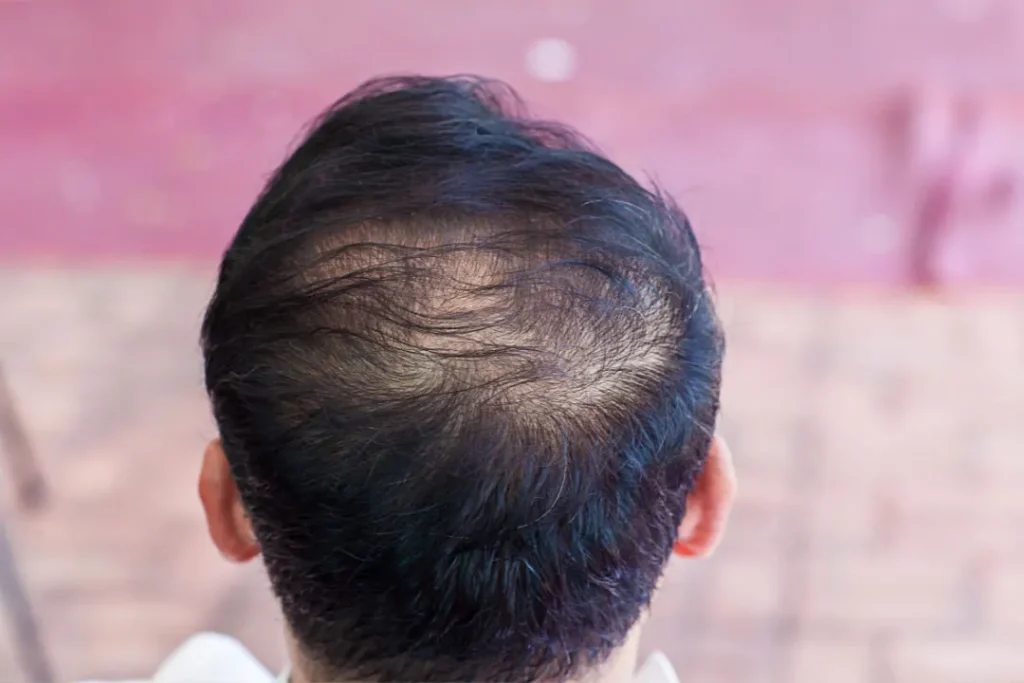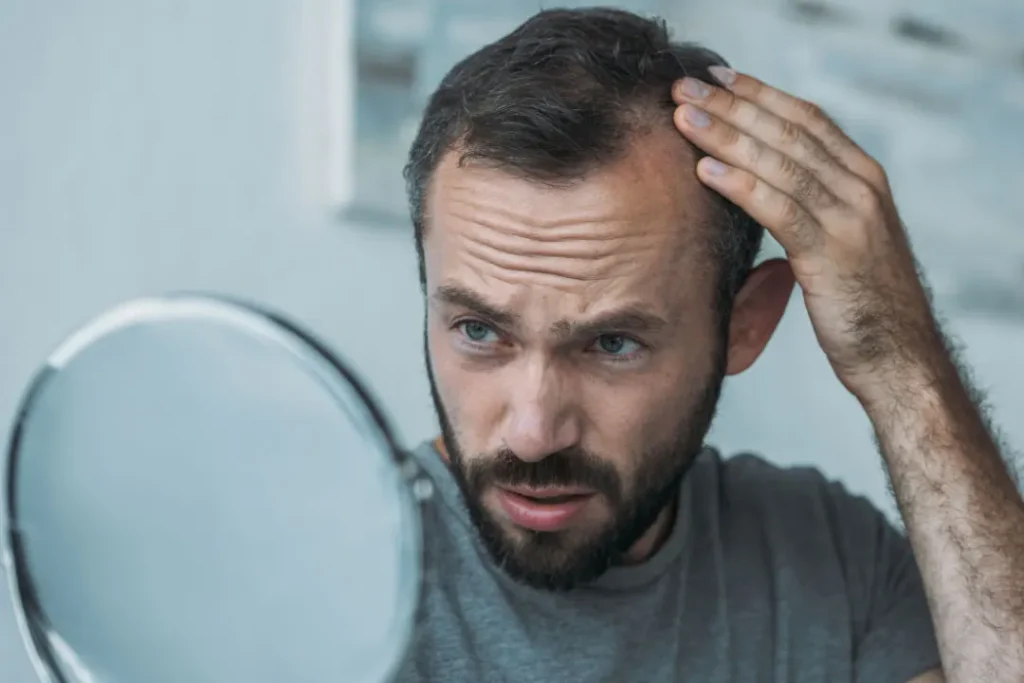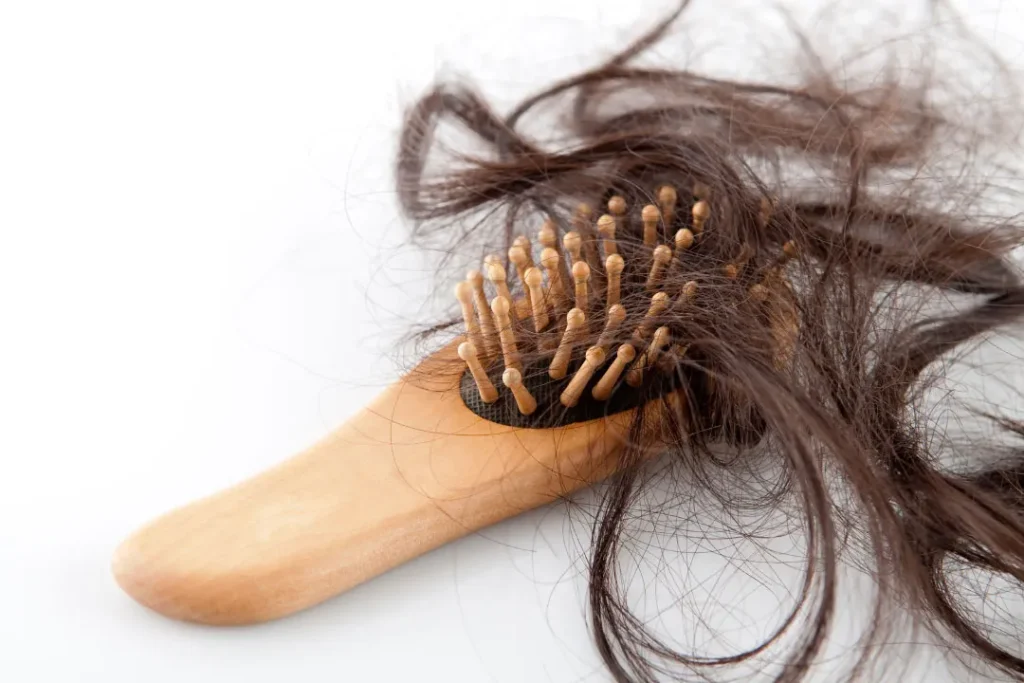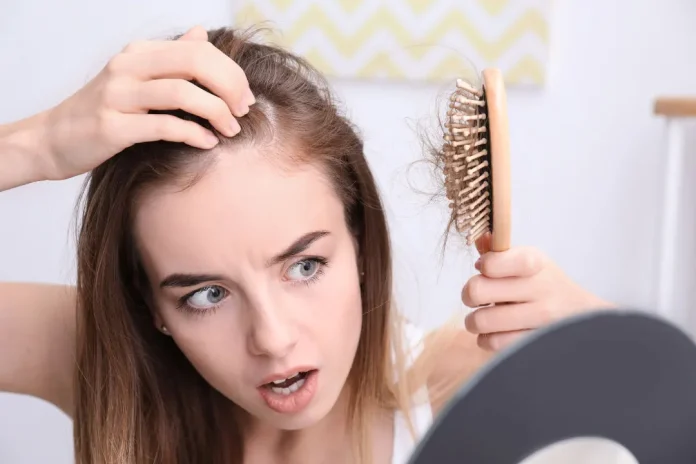Male Pattern Baldness, a condition that affects a majority of men over 50, has long been a subject of interest and research. Many people wonder whether testosterone plays a role in hair loss. We’ll explore the relationship between testosterone and baldness and separate the myths from the facts.
There are several causes of hair loss, but one of the most common is male pattern baldness. Male pattern baldness is a genetic, hereditary type of hair loss primarily affecting men. It usually begins with thinning hair around the hairline and crown of the head, hence the “pattern” in the name.
Male pattern baldness is often associated with the hormone testosterone, commonly called the primary “masculine” hormone. However, this is a myth. While the body’s processing of testosterone is somewhat related to some instances of male pattern baldness, there is no direct correlation between the two.
You May Also Like:
Dr. Teal’s Sleep Spray vs DELTA BrainLuxury
Thorne Deep Sleep Supplement vs DELTA BrainLuxury
Testosterone and Baldness… Is There a Link? is an original (OptimalHealthNews) article.
Testosterone and Baldness:
The role of DHT
Testosterone does not cause male pattern baldness; a compound called dihydrotestosterone (DHT) may play a role. The human body produces testosterone in the glands of the testes, after which it processes testosterone into any number of byproducts for various uses. One of those byproducts is DHT. DHT plays a role in sexual development, stimulating the generation of male secondary sex characteristics during fetal development and puberty.
Ironically, it’s responsible for hair growth everywhere but on the top of your head. An excess of DHT in the body can be detrimental to your health; it can be a precursor to prostate cancer and, in some women, may lead to polycystic ovary syndrome (PCOS). Too much DHT can also lead to male pattern baldness.
DHT binds to 5-AR proteins, naturally occurring enzymes in the body’s metabolism processes. It can create masses that block blood vessels, particularly those leading to healthy hair follicles. Cut off from their supply of necessary nutrients by the DHT-protein pairs, these follicles are deprived of their circulatory system-granted benefits and will slowly wither and die. A typical hair loss treatment, Finasteride, prevents DHT from bonding to 5-AR proteins so they cannot block blood vessels and destroy healthy follicles.

Testosterone and Baldness:
Other potential causes of hair loss
There are many other potential causes of hair loss besides testosterone and DHT. Environmental factors may play a role in hair loss. Stress is a common culprit, as are specific medical treatments like chemotherapy and radiation. Overusing certain heat-based styling products or hair dyes can also damage the follicles, resulting in hair loss, as can frequently wearing tight braids or cornrows.
An insufficient dietary intake, or one that’s too high in sugar or fish-derived mercury, can also contribute to baldness. Overexposure to cigarette smoke may also harm your hair’s health. Although alcohol doesn’t contribute to hair loss, the repeated dehydration caused by alcohol abuse does. Finally, environmental pollution, including air- and water-borne toxins, can damage follicular health. Avoiding these ecological factors can help prevent hair loss.
Other conditions besides male pattern baldness may also contribute to hair loss. Alopecia areata is an autoimmune disease in which the body’s immune system attacks healthy follicles. This autoimmune reaction can result in a patchier pattern of hair loss than male pattern baldness, with a series of bald areas, each about the size of a quarter, appearing throughout the scalp.
There are multiple subtypes of alopecia areata: one that affects the head alone (alopecia areata totalis) and one that affects the entire body (alopecia areata universalis). Other types, like diffuse alopecia areata, only result in widespread hair thinning instead of bald patches. Still others, like ophiasis alopecia areata, have distinct, ringlike hair loss patterns. There are treatments for these alternate causes of hair loss, but the most effective type depends on your particular case.
More causes of hair loss do not yet have all-encompassing explanations or treatments. Frontal fibrosing alopecia is one such cause, affecting hair at the front and sides of the scalp as well as other parts of the body (often the eyebrows). While treatment options can slow its progress, hair loss due to frontal fibrosing alopecia is irreversible. Potential causes of this condition include autoimmune disorders, genetic heredity, and hormonal imbalance.

Testosterone and Baldness:
A potential solution
Traditional treatments for hair loss, like Finasteride and Minoxidil, are imperfect. While they address the problem at its source, they have various adverse side effects, like scalp irritation and sexual dysfunction. An alternative treatment comes in the form of stem cell therapy.
The brand More Hair Naturally is an industry leader and exemplar in the space for stem cell-based hair loss therapy, and their product More Hair Naturally 9 is an excellent starting point for anyone new to stem cell therapy for hair growth. Stem cells play a vital role in hair health, signaling healthy follicles when more growth is needed. Those essential stem cells can die with DHT blockages of follicular blood vessels, preventing follicles from receiving the necessary communications to induce growth.
Using stem cell therapy to restore the communicative link can lead to restored hair growth without using side effect-inducing drugs. Plus, unlike those drugs, More Hair Naturally is designed to be an expedient solution; you may need to use it only briefly before moving on with your life (and your entire head of hair). Per CEO Mahryah Shain, “We want people to realize that you don’t have to sacrifice your health to have your hair, and you don’t have to be dependent on anything for the rest of your life.”

Testosterone and Baldness:
A limited view
Although testosterone is commonly associated with male pattern baldness, the truth is far more complex. DHT, a testosterone byproduct, can play a role in some cases. However, it is not a universal cause of hair loss. Other factors, including environmental toxins and lifestyle habits can play a part. Autoimmune conditions like alopecia areata may also be responsible, as may specific cancer treatments. Whatever the cause, hair loss is a complicated issue with an uncomplicated remedy in the form of stem cell treatment.
For further reference:
Northwestern Now: Stem cells lose their ‘glue’ and escape from hair follicle
Mayo Clinic: Stem Cells
NIH National Library of Medicine: Stem cells from human hair follicles
Important Note: The information contained in this article (Testosterone and Baldness… Is There a Link?) is for general informational purposes only, and should not be construed as health or medical advice, nor is it intended to diagnose, prevent, treat, or cure any disease or health condition. Before embarking on any diet, fitness regimen, or program of nutritional supplementation, it is advisable to consult your healthcare professional in order to determine its safety and probable efficacy in terms of your individual state of health.
Regarding Nutritional Supplements Or Other Non-Prescription Health Products: If any nutritional supplements or other non-prescription health products are mentioned in the foregoing article, any claims or statements made about them have not been evaluated by the U.S. Food and Drug Administration, and such nutritional supplements or other health products are not intended to diagnose, treat, cure, or prevent any disease.
